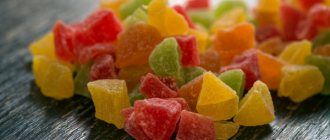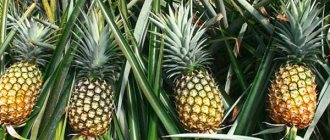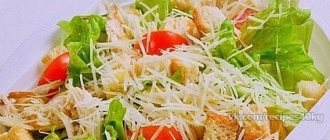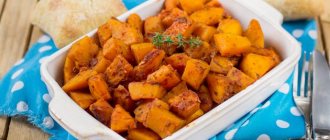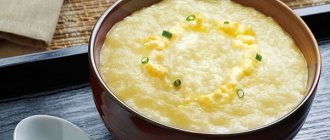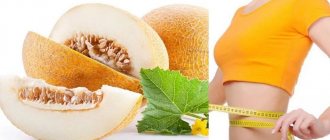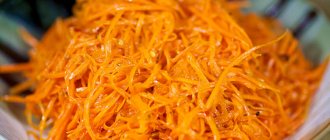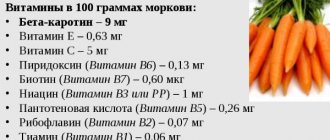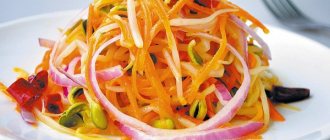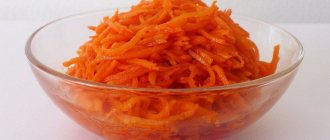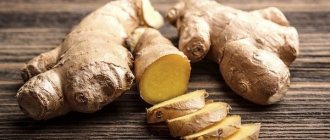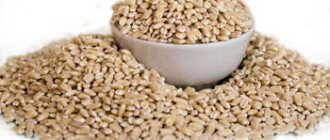Publication in the group: Desserts
Candied fruits began to be prepared in the hot countries of the East, so that the quickly ripening, perishable fruits would not harm the body and preserve their beneficial substances for a longer time. Then this hearty delicacy spread throughout the world; it is known that already in the 14th century in Rus' they prepared dry jam called balabushki. The healthy, dense pulp is cut into small cubes, and then soaked or boiled in sweet hot syrup, followed by drying at high temperatures in the sun or in the oven. The manipulations are repeated several times to completely remove moisture from the fruit.
In modern times, depending on the technological method, the following types of preparation of candied fruits have appeared in industry:
- The folding method involves long-term simmering in sugar syrup and then drying in a hot oven, as a result of which a hard sugar crust with a white coating forms on the surface of the sweets.
- Circulated candied fruits are prepared by immersing them in a sweet solution for several minutes, followed by simmering at a low temperature and blowing with cold air, as a result of which a transparent light glaze is formed on the fruit pieces.
- Candied fruits are also glazed, but in a slightly different way. They are kept for 6 hours in hot sugar syrup, and then dried for a long time in gentle heat until the glaze is completely dry.
Calorie content, BJU, GI
Candied fruits (the benefits and harms to the human body largely depend on the amount of consumption) are prepared from hard fruits and vegetables with the presence of large amounts of sugar, which acts here as a preservative.
Due to this, the delicacy has a high calorie content:
| Energy value per 100 g | |
| fruit | 322 kcal |
| vegetable | 216 kcal |
| Number of BZHU | |
| proteins | 0,4% |
| fat | 0,08% |
| carbohydrates | 99,5% |
The glycemic index of candied fruits can be equal to that of pure glucose, and on average ranges from 75 to 100 units.
Can candied fruits be used for weight loss?
Since such sweets are boiled in a high concentration of sugar syrup, they can hardly be called dietary products. For example, the calorie content of candied mango is 280 kcal per 100 grams, which is quite a lot if you are planning a diet.
But if you really want sweets, then it is better to eat them, and not factory-made sweets, so you will get a portion of vitamins and satisfy your need for sugar.
Candied fruits can be used for weight loss for the following reasons:
- candied fruits are made from fruits or vegetables; these products contain fiber, which helps cleanse the intestines of toxins;
- A person who is losing weight often limits their diet, reducing their intake of nutrients, thereby increasing the likelihood of catching a cold. Candied citruses and ginger strengthen the immune system;
- restricting nutrition during a diet can lead to the loss of important vitamins and substances, and the vitamins A, B, C contained and the substances potassium, iron and magnesium are preserved in candied fruits, albeit in small quantities. Thanks to the consumption of sweets, you can replenish the necessary substances;
- Ginger and pineapple are excellent aids in losing weight; they have a good effect on fat deposits and help break them down. For women this will certainly be an advantage, because... they are more addicted to sweets.
The calorie content of candied pineapple fruits is extremely low - only 91 kcal per 100 grams, which is best consumed during a diet.
Beneficial features
Candied fruits (the benefits and harms to the body are largely determined by the method of processing) when used wisely in limited quantities can have a positive effect:
- These sweets have fewer calories than many confectionery products and industrial sweets, therefore they are considered a healthier and more dietary dessert for children, as well as for those who follow healthy eating and lose weight.
- Some vitamins and minerals remain unchanged and are not destroyed during heat treatment of fruits, so they can enrich the body with carotene, biotin, nicotinic acid, potassium, magnesium and iron, as well as other useful substances.
- The fiber retained in the delicacy improves intestinal function and promotes the functioning of favorable microflora, which in turn leads to cleansing the body of toxins and wastes.
- Useful antiseptic substances in candied ginger or orange help increase the body's protective functions and strengthen the immune system.
- For traveling and working people, candied fruits can be a very convenient way to quickly replenish energy, which is especially convenient when access to regular food is limited.
- This can be an excellent addition to porridge or a decoration for various healthy casseroles, cottage cheese or yoghurts.
Candied fruits are more beneficial than harmful, so they can be added to different dishes. - Healthy pectin normalizes cholesterol levels and reduces the risk of many diseases.
Benefits of candied fruits for the body
Each fruit contains its own complex of vitamins and minerals, but do not forget that when cooked, most of the beneficial substances evaporate along with the water. Some substances are retained and most often these are:
- vitamin A – ensures the functioning of mucous membranes, normalizes vision, improves the elasticity of the skin;
- B vitamins improve the condition of the nervous system, increase resistance to stress, stabilize blood sugar and reduce cholesterol;
- potassium has a special effect on the regulation of heart rate and pressure; potassium ensures the elasticity of blood vessels, protecting against the formation of plaques;
- since candied fruits are practically a natural product, because they contain only fruits, or rather vitamins and sugar, such a dessert can be eaten on a diet, receiving a dose of vitamins and favorite sweets, with a low calorie content;
- rapid restoration of energy and elimination of toxins, with moderate consumption.
Each type of candied fruit has a beneficial effect on the body:
- candied oranges help treat asthma, fight colds and remove phlegm;
- pineapple sweets contain the substance bromelain, which helps burn fat inside the body, which promotes weight loss;
- The benefits of dried mango are great: strengthening the immune system, normalizing digestion, increasing concentration and memory, and returning metabolism to normal.
Candied fruits are an excellent dessert and a source of nutrients; sweet pieces will not only give positive emotions during a snack, but also benefit your body.
For children
Sweets should not be given to children under 3 years of age, because... Harm can be caused to a fragile body. The daily intake consumed by children should not exceed 40 grams. And do not forget that sweetening dishes at an early age is also not advisable.
Children over 3 years old can be given no more than 2-3 tbsp. spoons of sweet fruits per day. We advise you to give homemade candied fruits, the composition of which you will be sure of. They are an excellent substitute for regular sweets and replenish the balance of essential substances in the body.
Important! If you decide to treat your child before the required age, be sure to consult a doctor.
Harm and contraindications
Candied fruits (the benefits and harm to the body directly depend on the composition and method of production of the delicacy) if consumed in moderation can harm even healthy people, and for patients with diabetes and obesity, this delicacy is contraindicated in any quantity.
In addition, the dyes and preservatives contained in industrial sweets can cause allergic reactions, indigestion or digestive disorders. This delicacy is also contraindicated for use by children under 3 years of age.
The high content of sugar and fruit acids can cause harm to thinned tooth enamel, so people with a predisposition to caries and increased tooth sensitivity should use candied fruits with caution.
Composition of candied fruits
Nutritional value 100 g:
- Calorie content: 216.4 kcal
- Proteins: 3 g
- Carbohydrates: 54.5 g
Show full list »
Macronutrients:
- Calcium: 115 mg
- Magnesium: 92 mg
- Sodium: 141 mg
- Potassium: 2043 mg
- Phosphorus: 192 mg
Vitamins:
- Vitamin PP: 2.1 mg
- Beta-carotene: 1 mg
- Vitamin A (VE): 166.6667 mcg
- Vitamin B1 (thiamine): 0.03 mg
- Vitamin B2 (riboflavin): 0.2 mg
- Vitamin C: 5 mg
- Vitamin PP (Niacin Equivalent): 2.598 mg
Microelements:
- Iron: 3 mg
As for the composition of the product in question, everything is simple - it contains vitamins and sugars (fructose, glucose and others). Much depends on how the candied fruits were prepared - unscrupulous manufacturers add chemical dyes to the delicacy. They give the product a bright color and an attractive/appetizing appearance, but they also destroy everything useful that candied fruit contains.
Classic pineapple recipe
Preparing aromatic candied fruits from ripe pineapples can be considered a classic method, since the recipe uses a minimal amount of ingredients.
Composition of ingredients
For this easy-to-prepare homemade delicacy, you need to prepare a minimum set of products:
- 1 ripe ripe pineapple;
- 0.5 liters of clean drinking water;
- 750 g granulated sugar;
- 2 tbsp. l. powdered sugar.
Step-by-step cooking process
First you need to cut the pineapple pulp, remove the peel and hard core, and cut the fibrous part of the fruit into equal small cubes.
Further:
- Now you should prepare the sugar syrup in a large spacious saucepan and cook it over low heat.
- Then place the prepared pieces of fruit so that they float freely in the sweet liquid.
- In 10 minutes. low boil, turn off the heat and leave the pieces of fruit to cool in the syrup.
- Pieces of pineapple pulp should be well saturated with the sweet solution, for which they should be allowed to brew for 3-4 hours.
- Then put the pan back on low heat and bring the syrup to a boil, boil the fruit for 10 minutes, turn off the heat. So it is necessary to repeat the entire sequence of actions 2-3 more times.
- Then you should strain and place the candied fruit pieces on a wire rack or baking sheet with baking paper, place them in an oven preheated to 70 degrees for 6-7 hours.
What can I add?
You can dry pineapples boiled in syrup at room temperature or near a radiator, then the process will take 2-3 days.
How to serve a dish
Ready-made candied pineapple fruits should be rolled in powdered sugar, which will prevent the pieces from sticking together. The delicacy can be served as a dessert on its own or used in making homemade muffins.
Types of candied fruits
Candied fruits are pieces of fruits, vegetables and berries boiled in thick syrup. After boiling, the product is dried and subject to long-term storage. It is believed that the technological process of preparing candied fruits is very simple, but it requires a lot of time and some experience from the housewife. It is much easier to buy ready-made candied fruits in stores - they are presented in a wide range.
Candied fruits, depending on what source material the sweet was made from, can have different colors and tastes. The most popular among consumers are candied pineapple, coconut and papaya. In general, keep in mind that the product in question can only be prepared from hard varieties of fruit - it is unlikely that strawberries or watermelon will make a decent delicacy, although watermelon rinds are used for candied fruits.
Candied fruits also differ in their shapes - they can be round, square and even complex figured shapes. This does not affect the taste in any way, but for the use of candied fruits when decorating confectionery products, this point can play an important role.
Candied Ginger Recipe
Candied fruits (the benefits and harm to the human body depend on the composition, method of production and transportation of the delicacy) are best made independently, following the most healthy natural preparation technology.
Composition of ingredients
For a fragrant and healthy spicy dessert, you need to take the following ingredients:
| Component | Quantity |
| Fresh ginger root | 500 g |
| Granulated sugar | 3 tbsp. |
| Clean drinking water | 750 ml |
| Powdered sugar | 2 tbsp. l. |
Step-by-step cooking process
First, you need to rinse the ginger roots well, break them into small pieces and remove the skin, trying to remove it as thinly as possible, since there is a large amount of useful substances underneath.
Further:
- The peeled ginger pulp should be cut into equal-sized pieces or thin strips, and then filled with cold drinking water for 3 days, changing the liquid periodically. It is recommended to do this at intervals of at least 10-12 hours.
- Now you need to place the soaked pieces in boiling water and boil the ginger for 60 minutes, then drain it in a colander or sieve to drain all excess liquid.
- After this, you should prepare a thick sugar syrup, and mark the prepared preparations in it, cook for about 1 hour, then cool and repeat the procedure 2 more times so that the ginger is well saturated with sugar and becomes transparent.
- After this, the candied fruits must be carefully removed from the sweet syrup with culinary tongs, rolled in powdered sugar and transferred to dry at room temperature on a flat plate or wire rack, keeping the distance between the pieces so that they do not stick together.
What can I add?
You can add a cinnamon stick and 4-5 buds of dry cloves to the syrup for additional spice. After preparation, the aromatic decoction is suitable for adding to tea or compote. You can add citric acid powder to the powdered sugar, which will give the delicacy a pleasant freshness.
How to serve a dish
The finished delicacy can be stored in a tightly closed glass jar in a place protected from light for about 3-4 months. When consumed, put the required amount into a socket and serve with aromatic tea or strong coffee.
Production technology
Content:
- Production technology
- Chemical composition
- How to distinguish a natural product from a fake
- Benefits and harms
- Conclusion
Currently, candied fruits are not a scarce product. They can be purchased at any supermarket, confectionery shop or bazaar, both packaged and in bulk. However, today's candied fruits are bright “cubes and sticks”, usually dry and coarse-fibered, with a sickly sweet taste. The question arises: what are they made of? Manufacturers often limit themselves to the label “tropical sweets,” which does not convey anything specific. One can only guess what is hidden under this epithet...
Nutritionists do not recommend purchasing brightly colored candied fruits with a distinct fruity smell, since this indicates the introduction of a large number of dyes, flavors and preservatives into the product, the consumption of which will not make a person healthier. To protect yourself and your loved ones, it is recommended to prepare oriental sweets yourself. This is the only way to be sure of the quality and naturalness of the raw materials and the authenticity of the finished dessert.
Most often, candied fruits are made from apricots, plums, cherries, apples, pears, pineapples, carrots, pumpkins, lemon, watermelon and melon peels. However, zucchini, beets, cherry plums, grapes, peaches, and quinces can also be used as raw materials. The delicacy is prepared from fresh or frozen fruits, berries and even jam.
The technology for the production of oriental sweets can be divided into 4 stages: preparation of raw materials, blanching and aging in sugar syrup, drying, glazing or sprinkling.
Let's take a closer look at how to prepare candied fruits:
- At the first stage, the fruits or peels are washed, cleared of pulp and seeds, and cut into cubes or strips measuring 10 mm x 10 mm or 10 mm x 25 mm. Watermelon and melon skins are additionally kept in cold water for 2 days until the salty taste is completely eliminated.
- At the second stage, the fruits and peels are placed in boiling water for 10 minutes (blanching process), then they are removed from the liquid and poured with hot sugar syrup, brought to 90 degrees, with a concentration of 60% and left for 8 hours. This time is enough for the fruit to soak, “preserve” and become sweet in taste.
- The fruits are unloaded onto a wire tray with a cell diameter of up to 7 mm. You must wait until the syrup has completely drained. To speed up the drying of candied fruits, they are blown with cold or warm air and placed in dryers. At the same time, the dry matter content in the finished product must be at least 80%.
The syrup in which the fruits were aged is used to create jam and jam.
- The final stage of candied fruit production is sprinkling them with granulated sugar or glazing. In the first case, the fruits are rolled in sweet powder. The amount of granulated sugar should not exceed 15% of the weight of the fruit. The fruit processing process is as follows: dried cubes or sticks of berries are fed onto a perforated metal drum with a hole diameter of up to 7 mm, which rotates continuously. In it, sugar is evenly distributed over the surface of the candied fruit. In this case, sprinkling should be done manually.
In the second case, glazing is done in sugar syrup, the concentration of which depends on the type of fruit. Thus, for melon and watermelon rinds it does not exceed 80%, apricots, peaches and plums – 82%, pome fruits, citrus fruits, figs – 83%.
The prepared syrup is poured into two-body glazing boilers based on the calculation of 15 kg of dried fruits per 30 dm3 of sweet liquid. The candied fruits are mixed with a slotted spoon, boiled at a gentle boil, and replicated, as a result of which sugar crystallizes on the surface of the fruit and a transparent film is formed - glaze. Then the fruits are carefully removed and dried again.
Properly prepared candied fruits are covered with a shiny, glassy, light and transparent film of glaze through which the natural color of the fruit is visible. They do not contain sugar deposits and signs of spoilage (mold, fermentation) caused by the vital activity of organisms.
The shelf life of ready-made candied fruits is 6-12 months in a dry room at an ambient temperature of 5-20 degrees, relative humidity 75%. The candied fruits are stored in a glass container.
Citrus recipe
The benefits of natural aromatic candied orange or lemon peels for the body in many ways exceed the harm from consuming industrial sweets and industrial desserts, and preparing this tasty delicacy at home will not be difficult or costly.
Preparation next.
Composition of ingredients
To prepare citrus sweets you will need the following ingredients:
- 500-600 g orange, lemon or pomelo peels, you can take assorted ones;
- 4-5 tbsp. l. freshly squeezed lemon juice;
- 500 g granulated sugar;
- 400 ml of filtered drinking water;
- 3-4 allspice peas;
- 1 pinch of cardamom;
- 1 dried star anise flower;
- 1-2 pinches of natural vanilla;
- 2 buds of dry cloves.
Step-by-step cooking process
Preparing candied citrus fruits takes a lot of time:
- It is necessary to thoroughly rinse the orange, pomelo and lemon fruits in hot water with a stiff brush, dry or wipe with a towel.
- You need to carefully remove the peel from citrus fruits, capturing about 10 mm of pulp. The hard ends should be discarded and the rest of the peels should be soaked in cold drinking water. The peel of the pomelo fruit should be soaked for at least a day, or 48 hours, changing the water several times and washing the peels.
- Now you need to boil about 3 liters of water in a spacious bowl and place chopped citrus peels in it, reduce the heat and cook for 4-5 minutes. at minimum boil.
- After this, you need to throw the boiled peel into a colander or sieve, and then rinse thoroughly several times in plenty of cold running water.
- Next, you should prepare sugar syrup from the components indicated in the recipe, boil it for about 5-10 minutes, and then place the dried peels of citrus fruits in it.
- After the syrup boils, you need to reduce the heat under the pan and cook the crusts for 1-1.5 hours.
- Then you need to turn off the heat and completely cool the solution in the pan, then put it in a cold place for 12 hours.
- Now you need to remove the crusts from the syrup, place them on a wire rack, and then cut them into beautiful pieces or even strips, place them on a baking sheet lined with baking paper and place them in an oven heated to 70-80 degrees for 6-8 hours. You can use a special electric oven for these purposes. dryer
- Next, the candied fruits need to be cooled completely, transferred to an airtight glass jar and stored in a dark place.
What can I add?
Orange and lemon pulp can be used to make syrup by squeezing out all the juice and then adding the required amount of water. Boiled citrus peels can not be dried in the oven, but stored in boiled syrup, placing the slices in small glass jars and placed in the refrigerator.
How to serve a dish
You can serve aromatic candied lemon, pomelo or orange with black or green tea instead of sweets, and also use it as a filling for baking or as an additive to porridge.
Chemical composition and benefits of raisins
| Like the majority of dried fruits, raisins come from the countries of the Near and Middle East. It is also popular in Mediterranean cuisine. |
At its core, raisins are dried grapes. And we can say that the chemical composition of raisins is somewhat reminiscent of the spectrum of benefits in grapes. In order to prepare raisins, the grapes are not seeded. If the technology is correct, if you get high-quality raisins, then they contain up to 70-80% of vitamins and about 100% of chemical elements from grapes.
And these are vitamins B and C, potassium, manganese, iron, boron, magnesium, copper, iodine, fluorine. At the same time, raisins contain pectin substances and fiber, organic acids and antioxidants, and sugars. Raisins retain only about 20% moisture.
Raisins are one of the healthiest and most popular types of dried fruits. Its calorie content is estimated at 264 kcal per 100 grams of product.
Raisins, due to the fact that they are dried berries, and therefore the concentration of nutrients in them is an order of magnitude higher than in fresh ones, cannot be eaten without moderation. As with any product containing raisins, moderation must be observed.
There are four varieties of raisins:
- light and small - usually prepared from sweet berries of white varieties, for example, sultanas;
- medium-sized light olive - there are seeds inside;
- dark (blue, burgundy or black) - very sweet or slightly sweet, dryish consistency, made from blue grape varieties;
- large, fleshy, very sweet, pleasant to the taste - made from the “lady fingers” variety, you can come across several seeds inside.
Before use, any grapes should be soaked for half an hour, and then rinsed well and used for their intended purpose.
In addition to the piquant taste and relevance both in desserts and in main courses, salads, raisins are valued for their effect on the human body. It consists of the following:
- strengthening the nervous system, normalizing the condition, eliminating excitability;
- improving sleep, eliminating insomnia;
- strengthening and healing the heart and lungs due to the high content of potassium and magnesium;
- prevention of general weakness and digestive disorders;
- recovery from kidney disease, after fever;
- increasing immunity;
- increased libido;
- prevention of anemia due to high iron content.
Raisins (especially in combination with nuts and honey) are recommended for pregnant women. The value in this case is in the same B vitamins and iron. Raisins also increase lactation.
However, there are conditions in which you need to be careful with raisins. These include:
- diabetes,
- peptic ulcer of the stomach and duodenum,
- ulcerative processes in the oral cavity,
- enterocolitis,
- active form of pulmonary tuberculosis,
- severe obesity.
Pumpkin recipe
A fragrant and healthy delicacy for children and adults made from bright pumpkin can be easily prepared in your home kitchen.
Preparation next.
Composition of ingredients
For this recipe you need to prepare the ingredients in the following proportions:
- 1 kg of peeled pumpkin pulp;
- 1 tsp. honey;
- 100 g granulated sugar;
- 1 tsp. peeled walnuts;
- 3 tsp. powdered sugar.
Step-by-step cooking process
First you need to thinly slice the pumpkin pulp into equal strips, no more than 3 mm thick:
- It is necessary to place the pumpkin slices in a spacious saucepan, sprinkling the layers with granulated sugar and put them in the refrigerator for 5-8 hours to release the juice.
- After this, you should set the bowl with pieces of pumpkin in sugar juice on low heat and cook until the sugar grains are completely dissolved.
- In 20 minutes. When boiling slowly, remove the pumpkin pieces from the syrup and transfer them to a wire rack to cool completely.
- Now thin slices can be rolled into loose rolls and placed on a parchment-lined baking sheet or electric dryer tray in 1 layer, keeping the distance between the edges.
- Dry candied pumpkin at low temperature for 6-7 hours, then sprinkle with powdered sugar on all sides and cool completely.
What can I add?
Prepared healthy sweets should be stored in a glass container under an airtight lid, protected from light.
How to serve a dish
Before eating, it is recommended to pour candied pumpkin with liquid honey and roll in crushed walnuts.
Natural benefits
Since the sweet delicacy has a predominantly natural composition (fruit, vegetable or berry), there are many beneficial properties in the finished product. The most important of them:
- Candied fruits are simply a storehouse of vitamins (A, B, C and many others); they contain nicotinic acid, glucose, ruboflavin and thiamine.
- Rich in various minerals such as calcium, potassium, magnesium, iron, phosphorus and sodium.
- They normalize metabolism in the body , invigorate and give a charge of vitality and energy, launch the processes of rejuvenation and regeneration.
- Helps maintain normal hemoglobin levels and stimulate the immune system.
- The high fiber content helps to improve digestive processes, stimulates intestinal function and eliminates toxins.
- The presence of pectin keeps cholesterol within acceptable limits, helps lower blood sugar and significantly reduces the risk of skin cancer.
- During illness or in the postoperative period, candied fruits help the body recover and cope with the disease faster.
- If a person is engaged in heavy mental or physical labor and burns a large amount of carbohydrates during working hours, then candied fruits will help restore balance.
Carrot recipe
Candied carrots made from affordable carrots are very bright and tasty and serve as an excellent replacement for unhealthy sweets during the long winter.
Preparation next.
Composition of ingredients
For this healthy treat, you need to prepare the following ingredients:
- 0.5 kg of peeled carrots;
- 1 tbsp. granulated sugar;
- 100 ml water with lemon juice;
- 1 tbsp. l. lemon zest.
Step-by-step cooking process
Peeled and cut into equal size pieces of carrots should be placed in boiling water for 1-2 minutes, then removed and dried.
Further:
- In the meantime, you need to boil granulated sugar syrup with the addition of zest, and then place blanched carrots in it, cook for about 15 minutes. over low heat, and then remove the pan from the stove, let the mixture cool and brew.
- You need to repeat the procedure 2-3 more times so that the carrot slices acquire a translucent appearance.
- After this, place the candied fruits on a wire rack, allow the syrup to drain and dry in the oven or at room temperature.
- The finished delicacy should be generously rolled in powdered sugar or sand so that they do not stick together during storage.
What can I add?
You can add cardamom or fresh ginger root to the syrup, which will add new flavors to the dish.
How to serve a dish
You can serve carrot sweetness with tea instead of sweets or jam.
What are candied fruits?
For the first time, candied fruits began to be produced in the East, since due to the heat the fruits quickly deteriorated, it was decided to produce this delicacy. To make candied fruits, fruits and berries are used, as well as some vegetables and even nuts.
When preparing, you should choose a hard fruit for candied fruits; the products are cut into small pieces and boiled in sugar syrup, then they are dried naturally or in the oven and sprinkled with powdered sugar so that the pieces do not stick together.
In addition to fruit, the composition contains sugar, however, all the beneficial properties of the products are preserved. This is an excellent healthy dessert and a replacement for modern marmalade and other sweets.
Vegetable sweets are often made from pumpkin, beets and carrots, but drying them completely is problematic, so they are often sprinkled with chocolate.
From zucchini
Healthy sweets can be prepared from ordinary zucchini, the harvest of which pleases with its quantity in summer and autumn.
Preparation next.
Composition of ingredients
To prepare candied fruits for future use, you will need a set of the following components:
- 1 kg of zucchini pulp, peeled and seeded;
- 1 large orange;
- 200 g granulated sugar;
- 4-5 tbsp. l. honey;
- 2 tbsp. l. powdered sugar.
Step-by-step cooking process
The squash pulp should be cut into equal pieces, placed in a spacious saucepan and evenly sprinkled with granulated sugar, put in the refrigerator for 10-12 hours to release the juice.
Recipe:
- A well-washed orange, scalded with boiling water, should be cut into small pieces, remove the seeds and place in a blender bowl along with the peel, and prepare a homogeneous puree.
- Add the juice released from the zucchini with sugar to the orange mixture, mix and put on fire.
- Then you need to add honey and cook the syrup for about 3-5 minutes. over very low heat.
- Now you should place the prepared pieces of zucchini into the sweet solution and continue to cook over low heat until translucent, periodically gently stirring all the components.
- Then the remaining syrup must be drained, the candied fruits should be laid out on a wire rack, dried well in the open air in a ventilated place for 2-3 days and sprinkled with powdered sugar.
What can I add?
Instead of orange, you can use lemons, which will give the finished sweets a sour note. You can quickly dry boiled pieces of zucchini in a warm oven with the door open in 3-4 hours.
How to serve a dish
Candied zucchini should be stored wrapped in parchment or in an airtight ceramic container.
Harm of candied fruits
Doctors recommend candied fruits with caution - after all, they contain a lot of sugar. Therefore, it is worth limiting the amount of candied fruits you eat - 2-3 pieces a day are enough for children. Too much consumption of the delicacy in question can lead to the development of caries, diathesis and obesity.
Please note: candied fruits are strictly not recommended for people with diagnosed stomach diseases. Diabetes mellitus is also a contraindication - a huge amount of sugar in sweets will be “killer”.
Candied melon recipe
Melon has a very bright, rich taste and aroma, so it is great for making candied delicacies, especially if you get a not very ripe fruit with hard pulp.
Preparation next.
Composition of ingredients
For such natural sweets you will need a minimum set of products:
- 1 kg of hard, not very ripe melon pulp;
- 1-1.2 kg granulated sugar;
- 250-400 ml of drinking water;
- 1 pinch of citric acid.
Step-by-step cooking process
The aromatic melon pulp must be freed from seeds and hard crust, and then cut into small identical cubes:
- In a spacious bowl, boil the concentrated sugar syrup, boil it for 5-7 minutes, and then place the prepared pieces of fruit in it.
- Boil the melon for no more than 5 minutes, then remove from heat and cover the dish with a gauze cloth.
- After 12 hours, you can put the pan with the syrup back on low heat, bring to a boil and cook for 3-5 minutes, and then set aside for 10-12 hours.
- The interval between cooking fruits can be increased, and the whole process should be repeated 3-4 times.
- During the last boiling of the fruit, citric acid must be added to the syrup, then cooled and the sweet solution drained.
- Candied melon should be evenly distributed on a flat surface covered with baking paper and left in the open air for 2-4 days, periodically turning the pieces over to dry evenly.
What can I add?
Instead of citric acid, you can use natural lemon juice, which must be added when first cooking the fruit.
How to serve a dish
Ready-made sweets must be generously sprinkled with powdered sugar or sand for better storage in a dark place. Melon sweets can also be wrapped in parchment and placed in the refrigerator.
Candied fruits - benefits and harm to the body
Everyone's favorite oriental delicacy, known today throughout the world, is candied fruit.
Bright aromatic fruit sweets are present on the table in almost every home. The dessert is perfect for both a festive event and an everyday tea party, and children are simply delighted with it. How pleasant it can be on a winter evening to open a box of multi-colored candied fruit cubes and enjoy the juicy taste of exotic fruits. But of course, there are both pros and cons to regularly eating such a tasty dessert. Let's figure it out.
From exotic fruits
You can easily make candied candied fruits from colorful mangoes and papaya at home.
Preparation next.
Composition of ingredients
- 1 kg of peeled fruit pulp;
- 500 g granulated sugar;
- 500 ml of clean drinking water.
Step-by-step cooking process
Mango and papaya fruits must first be washed well, dried and divided into pieces to remove the seeds, and then carefully remove the peel.
Further:
- After this, the fruits need to be cut into portion strips or identical cubes, spread out in an even layer to dry a little from the released juice.
- Then you need to cook and bring the thick sugar syrup to a boil, place pieces of papaya and mango in it, cook over low heat for 5-10 minutes.
- After this, the dishes should be removed from the heat and the fruit should be allowed to stand.
- Next, you need to carefully remove the candied fruit cubes using a slotted spoon, place them on a baking sheet lined with baking paper and dry with warm air using convection mode at a temperature of 45-50 degrees for about 2 hours.
What can I add?
You can add fresh lemon cut into thick slices to the sugar solution, which will add pleasant sour notes and a fresh aroma to the sweetness.
How to serve a dish
Soft, dried and completely cooled candied fruits should be generously sprinkled with powdered sugar or sand, and then placed in a ceramic bowl with a ground-in lid. Candied fruits can be made from most fruits and sweet vegetables with dense pulp. The raw materials must first be thoroughly washed and dried, and cleared of seeds and peels. Then the pulp should be finely chopped so that it is saturated with sugar faster and dries easier.
When preparing spicy candied ginger, the root must be cut into thicker pieces in the form of cubes or sticks. Thin slices have a less intense sweet taste.
Boiling fruits and vegetables in concentrated sugar syrup preserves their taste and aroma for a long time. A liquid sugar solution does not allow the fruits to be well candied, which can lead to spoilage of the product. Soft apple or peach flesh should be cooked in syrup for less time than hard pieces of pumpkin or carrot. It is advisable to strictly follow the instructions and recommendations of time-tested recipes for preparing natural sweets, without reducing the amount of sugar and cooking time.
Dry the finished delicacy at room temperature, turning it over periodically to ensure uniform cooking, in a well-ventilated area for at least 3-4 days. If necessary, you can place the candied fruits in the oven and cook them until cooked through even heating. The harm of store-bought sweets can be compensated by preparing natural homemade candied fruits, which, when consumed in moderation, will benefit the body, especially during the period of winter shortage of fresh fruits and spring vitamin deficiency.
Kinds
There are several ways to prepare candied fruits:
- Kanding. Prepared fruits are immersed for some time (from several hours to weeks) in concentrated sugar syrup. As a result of production in this way, fruits lose moisture, and their composition is filled with up to 70% sugar. The fruits are chosen to be hard and dense, so that instead of candied fruits you don’t end up with porridge.
- Folding. The fruits are boiled in syrup and sent to dry in the oven; as a result of cooking in this way, a thin film forms on the surface of the candied fruit.
- Circulated. Candied fruits are kept in high concentration syrup for 20 minutes and dried at a temperature of 50 degrees. An even sugar crust forms on the surface.
Candied and printed candied fruits refer to the glazed type of candied fruits; they are distinguished by the method of production. Candied ones are considered more useful because They are not boiled or dried at high temperatures; this method of preparation retains more nutrients.
Candied fruit
Candied fruits are pieces of fruit boiled in sugar syrup.
They are a traditional oriental sweet. The history of the delicacy is associated with the hot climate of countries in which sugaring made it possible to “preserve” fruits and preserve the harvest. Interestingly, in Rus' the product is called “dry jam”. Fruits soaked in sugar syrup are used as decoration for decorating rolls, puff pastries, cookies, cakes, and pastries. In addition, they are placed as a filling in shortbread, yeast, biscuit, cake and butter dough.
The delicacy serves as a natural substitute for sweets, contains fiber and organic acids, which help remove toxins and toxic substances from the body, instantly replenish energy costs (due to the breakdown of fast carbohydrates), and increase blood glucose levels.
How to prepare candied fruits at home?
Homemade candied treats cannot be stored for a long time. It should be prepared in small quantities. The easiest way to prepare candied fruits is from citrus peels, but you can also use slices. They are cut into medium-sized pieces so that they do not fall apart. Then put in ice water for a few minutes.
Preparation of syrup: take 1 part of water and refined sugar, mix until it is completely dissolved. Dip chilled fruits into this liquid and place the pan on low heat. Cook them for an hour, without bringing to a boil. Afterwards, the slices are thrown into a colander and the syrup is allowed to drain.
At this time, preheat the oven to 50 °C, cover the baking sheet with parchment paper. Place pieces of boiled fruit on it in one layer. Leave to dry in the oven with the door open for 5 hours.
After this time, the cooled product is ready for use. The benefit of candied fruits prepared at home is its naturalness. It is important to store them correctly: in a dry, dark place at a low temperature so that the fruit does not lose its properties.
Norm of candied fruits per day
How many candied fruits can you eat per day without harming your body or gaining weight? The number of calories during a diet is usually about 1400. At this rate, allow yourself no more than 50 grams of candied fruits per day. It just seems like this portion is not enough. In fact, you will get an impressive meal, since this delicacy is light in weight.
Nutritionists advise eating candied fruits before lunch. In this case, calories will not turn into a hoop around your waist. If you do physical labor, then you don’t have to set any restrictions for yourself. Consume candied fruits at any time of the day to get an energy boost when you need it. But the norms are still worth adhering to.
Candied fruits can replace a mid-workday snack. Wash them down with tea or natural coffee without sugar. Experts advise athletes to eat a handful of candied fruits before each workout. What is it for? To get rid of the feeling of hunger, which is especially important in the evening.
What are the benefits of candied fruits?
Candied fruits contain fiber. It is found in fresh fruits and berries and is not destroyed during processing. Its beneficial properties: improve intestinal function, cleanse the body of accumulated toxins.
Fruits prepared by natural glazing and drying retain beneficial vitamins and microelements. Heat treatment kills vitamin C, while others - A and B - are not afraid of boiling.
People engaged in heavy physical and mental work benefit from carbohydrates in large quantities. Candied fruits are an ideal product for them. Patients during the recovery period are also shown enhanced nutrition.
It is necessary to consume glazed fruits for various types of diseases only after consultation with your doctor. Only he can determine their benefit or harm for his patient.
Candied fruits are lower in calories than sweets. For people who adhere to a healthy diet, nutritionists even recommend consuming small amounts of them as a healthy snack.
For those with a sweet tooth who are unable to give up eating confectionery, they can be replaced with glazed fruit. The calorie content is low compared to candy, but there are more benefits. Modern technologies for preparing glazed fruits make it possible to preserve most of the beneficial properties of candied fruits.
Sweets made from vegetables: pumpkins, beets, carrots contain less carbohydrates, but more fiber. They are healthier than their fruit variety.
How to distinguish natural candied fruits from fakes
Housewives who prepare this delicacy at home know that when cooked, fruits lose their color. Store-bought dessert should also not be bright.
If you have any doubts when purchasing, you can take 10–20 grams of candied fruits for testing. At home, place them in hot water and stir. If they have not dissolved, they contain fruit. The liquid in the glass should not turn a bright color. Red or green water indicates the use of chemical dyes.
It is important to read the packaging: composition, expiration dates, calorie content. All these properties are indicated on the label during packaging. The fruit pieces should be elastic, dry, and not stick to each other.
